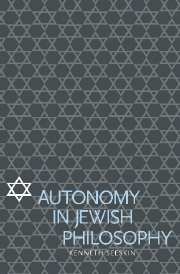Book contents
- Frontmatter
- Contents
- Preface
- Abbreviations
- 1 The problem of autonomy
- 2 Covenant and consent in the Bible
- 3 From the prophet to the sage
- 4 From the sage to the philosopher
- 5 The rise of modernity: Spinoza and Mendelssohn
- 6 The height of modernity: Kant and Cohen
- 7 Modernity under fire: Buber and Levinas
- 8 Conclusion: a partnership with God
- Bibliography
- Index
3 - From the prophet to the sage
Published online by Cambridge University Press: 22 September 2009
- Frontmatter
- Contents
- Preface
- Abbreviations
- 1 The problem of autonomy
- 2 Covenant and consent in the Bible
- 3 From the prophet to the sage
- 4 From the sage to the philosopher
- 5 The rise of modernity: Spinoza and Mendelssohn
- 6 The height of modernity: Kant and Cohen
- 7 Modernity under fire: Buber and Levinas
- 8 Conclusion: a partnership with God
- Bibliography
- Index
Summary
According to the traditional view, all 613 commandments which comprise the body of Jewish law were given to Moses at Sinai and became binding when Israel decided to live under the yoke of heavenly authority. Although human participation is needed for the commandments to be binding, no participation is needed to determine what the commandments are. In this respect, the Torah presents a decidedly heteronomous view of religion.
It is noteworthy that in addition to particular commandments, the Torah claims that the revelation given to Moses is final. Thus Deuteronomy 4:2: “You must neither add anything to what I command you nor take anything away from it, but keep the commandments of the Lord your God which I am charging you.” And Deuteronomy 13:1: “All this which I command you, you shall observe and do, you must not add to it or take anything away from it.” The rationale is clear: since the law is of divine origin, it is forbidden for humans to interfere with it. But there is an implication that is not so clear: if one cannot add to or subtract from the original body of commandments, then the role of a future prophet is greatly limited. Anyone who tries to change the law will show at once that he does not understand it.
- Type
- Chapter
- Information
- Autonomy in Jewish Philosophy , pp. 65 - 89Publisher: Cambridge University PressPrint publication year: 2001



